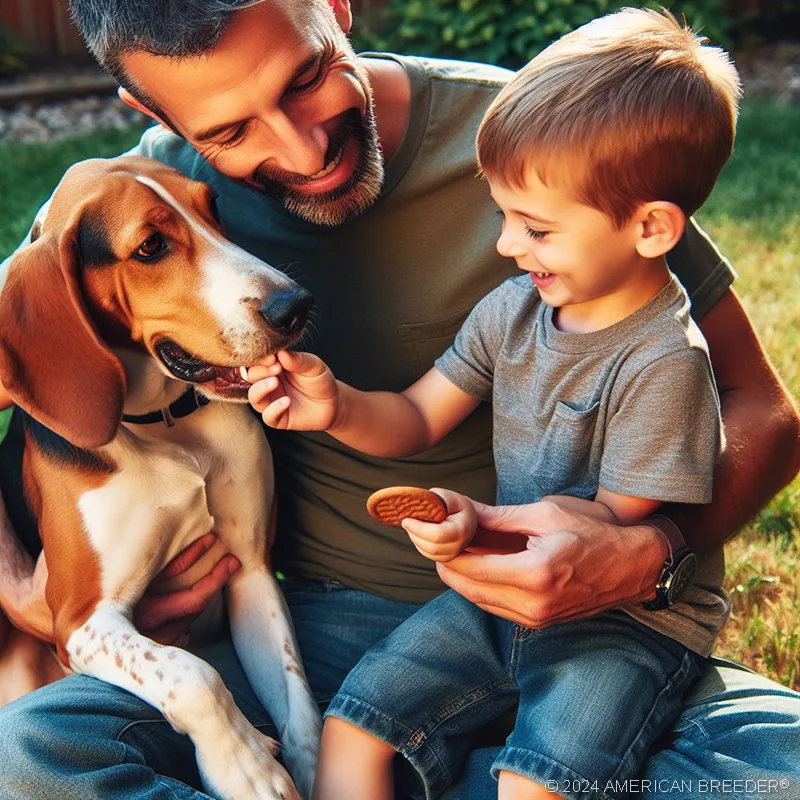Meet the Treeing Walker Coonhound: A True American Breed
Introduction and Breed Background
 Are you ready to welcome a lively and adventurous companion into your life? Look no further than the Treeing Walker Coonhound – a breed that embodies boundless energy, remarkable intelligence, and an unwavering zest for life. As you prepare to embark on this thrilling journey with your new furry friend, let's delve into the fascinating world of the Treeing Walker Coonhound, discovering their unique traits and what makes them a top choice for dog lovers seeking an enthusiastic and devoted companion.
Are you ready to welcome a lively and adventurous companion into your life? Look no further than the Treeing Walker Coonhound – a breed that embodies boundless energy, remarkable intelligence, and an unwavering zest for life. As you prepare to embark on this thrilling journey with your new furry friend, let's delve into the fascinating world of the Treeing Walker Coonhound, discovering their unique traits and what makes them a top choice for dog lovers seeking an enthusiastic and devoted companion.
Considerations to Understand Before Choosing This Breed:
Before embracing the excitement of adopting a Treeing Walker Coonhound, it's essential to understand their high energy levels and their need for daily physical and mental stimulation. They thrive in active families that can keep up with their playful nature and provide ample opportunities for exercise and adventure. These dogs love to be part of the pack, making them a wonderful addition to families with children and other pets. Their friendly and sociable demeanor means they will quickly become the heart and soul of your household.
Interesting Facts and Fun Tidbits:
Did you know that the Treeing Walker Coonhound is named after Thomas Walker, who was an influential figure in the breed's development? Originally bred from English and American Foxhounds, these intelligent hounds are renowned for their exceptional hunting abilities, particularly when it comes to "treeing" raccoons – cornering the raccoons up a tree to signal their location to hunters. While they excel in the field, their adaptability and affectionate nature also make them fantastic companions for urban and suburban living, as long as their exercise needs are met. Known for their distinctive howl and bay, you'll soon discover that their vocalizations are an endearing and characteristic trait.
Breed Background and History
 Origin and Development of the Breed:
Origin and Development of the Breed:
The Treeing Walker Coonhound hails from the United States and has a rich history intertwined with the sport of coon hunting. The breed's roots trace back to the 19th century when breeders aimed to create a hunting dog with exceptional tracking and treeing abilities. The result was the Treeing Walker Coonhound – a breed that could track game with remarkable speed and accuracy while alerting hunters to their position through their distinctive baying.
Historical Significance and Cultural Relevance:
Over the years, the Treeing Walker Coonhound became an integral part of the hunting community, known for its versatility and tenacity in pursuing raccoons, opossums, and other game. Their prowess in the field earned them a reputation as one of the finest coonhounds, beloved by hunters and enthusiasts alike. Today, while still excelling in hunting trials and competitions, these dogs have earned their place as beloved family pets and loyal companions.
Purpose or Original Use of the Breed:
The Treeing Walker Coonhound's primary purpose was, and still is, coon hunting. Their exceptional scenting ability, stamina, and agility allow them to track raccoons through various terrains, eventually treeing the game, which signals to the hunter the raccoon's location. Their specialized skills make them invaluable hunting partners, treasured for their unwavering determination and work ethic in the field.
Kennel Clubs that Classify or Register the Breed:
The Treeing Walker Coonhound is recognized by the American Kennel Club (AKC) and belongs to the Hound Group. Its registration with esteemed kennel clubs is a testament to its status as a well-respected and esteemed breed, acknowledged for its exceptional qualities and contributions to the world of hunting and companionship.
Appearance
 Size, Weight, Activity Level, and Physical Appearance:
Size, Weight, Activity Level, and Physical Appearance:
The Treeing Walker Coonhound boasts a medium to large size, with males typically ranging from 22 to 27 inches at the shoulder and weighing between 50 to 70 pounds. Females are slightly smaller, standing at 20 to 25 inches and weighing between 45 to 60 pounds. Their athletic build and well-muscled body give them an agile and powerful appearance – a testament to their hunting heritage. Being an active breed, they require plenty of exercise to maintain their robust physique and keep their exuberant spirits in check.
Coat Type, Color Variations, and Patterns:
The Treeing Walker Coonhound's short and dense coat is weather-resistant, ideal for hunting in various climates and terrains. While their coat may come in a variety of colors, the most common and recognizable coloration is the tricolor pattern of black, white, and tan. Their sleek and shiny coat adds to their regal appearance, complementing their intelligent and expressive eyes that sparkle with curiosity.
Distinctive Features or Markings:
One of the Treeing Walker Coonhound's most distinctive features is its long, elegant ears that beautifully frame its face. These expressive ears play a crucial role in capturing and funneling scents during hunts, giving them an edge in tracking game. Their alert and inquisitive expression perfectly mirrors their keen intelligence, while their strong tail serves as a visual cue to their excitement and enthusiasm.
Average Litter Size for This Breed:
When it comes to expanding their pack, Treeing Walker Coonhounds tend to have a moderate litter size, typically ranging from 6 to 10 puppies. Ensuring proper care and socialization of each puppy during their early developmental stages is essential to nurture their potential as skilled hunters and loving companions.
Temperament and Personality
 Typical Temperament Traits and Behavior Tendencies:
Typical Temperament Traits and Behavior Tendencies:
The Treeing Walker Coonhound is a true social butterfly, known for its friendly, affectionate, and outgoing nature. These dogs have a knack for making friends wherever they go, and their vivacious personalities bring an unparalleled sense of joy to their families. Their love for adventure and exploration means they are always eager to join in on any outdoor activities, making them the ideal partner for hiking, jogging, and outdoor excursions.
Energy Levels and Activity Requirements:
Get ready to keep pace with the energetic spirit of the Treeing Walker Coonhound! With a high activity level, they thrive in households that can provide them with regular opportunities for exercise and mental stimulation. Long walks, playtime in the yard, and interactive games are all essential to help them burn off excess energy and maintain their physical and emotional well-being.
Compatibility with Different Lifestyles and Family Dynamics:
The Treeing Walker Coonhound's adaptable nature allows them to thrive in various lifestyles, from active individuals seeking an outdoor adventure buddy to families with children who will adore their playful and affectionate disposition. They are social animals that enjoy being part of the family pack and will cherish any opportunity to join in on family outings and activities.
Typical Behavior Issues:
While the Treeing Walker Coonhound is generally a well-behaved and friendly breed, it's essential to address specific behavior issues that may arise. Early socialization and proper training will help prevent potential challenges such as excessive barking, especially during their hunting activities, as well as digging tendencies that may arise if they are not sufficiently stimulated and engaged. With patience, consistency, and positive reinforcement, these behaviors can be effectively managed.
Trainability and Intelligence
 Trainability Level and Ease of Learning:
Trainability Level and Ease of Learning:
As an intelligent breed with a desire to please their owners, Treeing Walker Coonhounds are highly trainable. They have a natural instinct for hunting and tracking, which can be harnessed through positive reinforcement-based training. Their eagerness to learn and willingness to follow commands make them excellent candidates for obedience training and various dog sports.
Intelligence and Problem-Solving Abilities:
The Treeing Walker Coonhound is a quick thinker with excellent problem-solving abilities. These traits stem from their hunting background, where they needed to analyze scents, terrain, and game behavior to succeed in the field. Their intelligence shines through in their ability to adapt to various situations, making them adept at tackling new challenges and learning new skills.
Recommended Training Approaches and Techniques:
When training a Treeing Walker Coonhound, positive reinforcement methods are key. Use treats, praise, and affection as rewards for desired behaviors, as this breed responds well to encouragement and positive interactions. Keep training sessions engaging and varied to prevent boredom and maintain their interest.
Best Suited Training or Skill Type for This Breed:
With their natural tracking instincts and athletic prowess, Treeing Walker Coonhounds excel in activities that tap into their hunting heritage. Engaging them in scent work, tracking exercises, and agility training will keep their minds sharp and their spirits high. These activities allow them to utilize their unique skills while fostering a strong bond with their human companions.
Health and Care
Common Health Issues or Predispositions of the Breed:
Although generally a healthy breed, Treeing Walker Coonhounds may be prone to certain health conditions, including hip dysplasia and ear infections. Regular vet check-ups and early detection of any health concerns can help ensure a long and happy life for your furry companion.
 Allergies and Specific Dietary Considerations:
Allergies and Specific Dietary Considerations:
As with any dog, it's essential to be mindful of potential food allergies and sensitivities. Providing a balanced and high-quality diet tailored to their specific needs will keep them in optimal health and maintain their energy levels.
Lifespan and Longevity Expectations:
On average, Treeing Walker Coonhounds live between 10 to 13 years, though with proper care, some individuals may exceed this range. Regular exercise, a nutritious diet, and regular vet check-ups all contribute to their overall well-being and longevity.
Grooming Requirements Based on Coat Type and Size:
The Treeing Walker Coonhound's short and dense coat is relatively low-maintenance, requiring weekly brushing to remove loose hair and keep their coat in excellent condition. Additionally, regular dental care, nail trims, and ear cleaning are essential components of their grooming routine.
Exercise Needs and Recommendations for Physical and Mental Stimulation:
To maintain their physical and mental health, Treeing Walker Coonhounds require at least one to two hours of exercise each day. Engaging in various activities, such as brisk walks, hiking, interactive play sessions, and puzzles, will satisfy their active nature and keep their curious minds engaged.
Nutrition and Feeding Guidelines:
As energetic dogs, Treeing Walker Coonhounds need a balanced diet that provides them with the necessary nutrients for their active lifestyle. Consult with your veterinarian to determine the best feeding plan and portion sizes for your individual Coonhound, taking into account their age, activity level, and health status.
Socialization and Compatibility
Interaction with Children, Other Pets, and Strangers:
With their friendly and sociable nature, Treeing Walker Coonhounds are excellent companions for families with children. Their patience and playful demeanor make them wonderful playmates for kids, and they are often seen as protective guardians for their little ones. Early socialization with other pets is essential, as their strong hunting instincts may trigger a chase response in some situations. Proper introductions and positive interactions can foster harmonious relationships within multi-pet households.
Socialization Needs and Tips for Proper Socialization:
Early socialization is critical for Treeing Walker Coonhounds to develop into well-mannered and confident adults. Expose them to various people, places, and other animals in a controlled and positive manner. This will help them grow into well-adjusted dogs that are comfortable and at ease in different social situations.
Precautions or Considerations for Multi-Dog Households:
While Treeing Walker Coonhounds are generally friendly towards other dogs, their hunting instincts may lead to chasing or dominance-related behaviors. Early socialization and consistent training can help mitigate any potential challenges and foster a harmonious relationship among your furry family members.
Level of Ease When It Comes to Training This Type of Dog Breed:
Due to their intelligence, trainability, and desire to please their owners, Treeing Walker Coonhounds generally respond well to training. However, consistent and patient training methods are essential, as their independent nature may occasionally lead to a touch of stubbornness. Using positive reinforcement and rewarding good behavior will make training a rewarding and enjoyable experience for both you and your Coonhound.
Living Arrangements and Environment
 Suitability for Different Living Arrangements (Apartment, House, Rural Area):
Suitability for Different Living Arrangements (Apartment, House, Rural Area):
While Treeing Walker Coonhounds have an adaptable nature, their high energy levels make them better suited for living in a house or rural area with ample space to roam and explore. They may find apartment living challenging, as they thrive in environments that provide opportunities for outdoor activities.
Space Requirements and Exercise Options for the Breed:
A medium to large-sized yard with secure fencing is ideal for Treeing Walker Coonhounds to stretch their legs and indulge in their adventurous spirit. Regular outdoor exercise, such as daily walks, hikes, or play sessions, will ensure they remain happy and content.
Climate Considerations and Adaptability:
Due to their dense coat, Treeing Walker Coonhounds are well-adapted to various climates. However, hot weather can be challenging for them, so ensure they have access to shade and plenty of fresh water during warmer months.
How Big of a Yard Should a Person Have with This Type of Dog?
For a Treeing Walker Coonhound, a yard with enough space for them to run, play, and explore is ideal. A securely fenced yard will allow them to indulge in their active nature safely. As with any dog, it's important to supervise them during outdoor activities to prevent potential escape attempts.
Training and Obedience
Basic Obedience Training and Commands
Start basic obedience training with your Treeing Walker Coonhound as early as possible to instill good manners and ensure a well-behaved companion. Teach them commands like sit, stay, come, and leave it. Positive reinforcement will strengthen the bond between you and your Coonhound while making training enjoyable for both.
Advanced Training or Specialized Activities Suited for the Breed
Take advantage of their sharp minds and exceptional problem-solving abilities by engaging them in advanced training and specialized activities. Activities like scent work, tracking, agility, and advanced obedience classes will provide them with mental stimulation and a sense of accomplishment.
Behavioral Challenges or Specific Training Considerations
While Treeing Walker Coonhounds are intelligent and eager to please, they may occasionally exhibit stubbornness or independence, especially if they detect an intriguing scent during walks or playtime. Patience and consistency are essential when addressing these behaviors. Redirecting their focus and using positive reinforcement to reinforce desired behaviors will yield excellent results.
Financial Planning
 What Is the Typical Price Range for Purchasing This Dog Breed from a Reputable Breeder?
What Is the Typical Price Range for Purchasing This Dog Breed from a Reputable Breeder?
When acquiring a Treeing Walker Coonhound from a reputable breeder, expect to pay an average price ranging from $800 to $1,500. Remember, investing in a well-bred puppy from a responsible breeder ensures not only a healthy dog but also supports ethical breeding practices that prioritize the health and well-being of the breed.
Initial Costs (Adoption Fees or Purchase Price, Vaccinations, Spaying/Neutering, Microchipping)
Upon bringing your Treeing Walker Coonhound home, the initial expenses will include the adoption fee or purchase price, which reflects the dog's pedigree and bloodline. Additionally, vaccinations are essential to protect your pup from preventable diseases, while spaying or neutering promotes responsible pet ownership and curtails the unwanted pet population. Microchipping is a small but vital investment that provides a permanent form of identification, ensuring your furry companion can be reunited with you if ever lost.
Ongoing Expenses (Food, Grooming, Veterinary Care, Training, Toys, and Supplies):
As responsible dog owners, it's essential to consider the ongoing expenses associated with providing the best care for your Treeing Walker Coonhound. Quality dog food tailored to their nutritional needs is a key investment in their health and well-being. Regular grooming, including brushing and occasional bathing, keeps their coat in pristine condition and prevents matting. Routine veterinary check-ups, vaccinations, and preventative medications are crucial to keeping them healthy and preventing potential health issues.
Training and enrichment classes, such as obedience or agility training, help foster a well-behaved and mentally stimulated dog. Providing them with engaging toys and essential supplies like a comfortable dog bed, food and water bowls, and a sturdy leash and collar complete their well-rounded care.
Overall Summary
Prepare to embark on an exhilarating adventure filled with the spirit of the Treeing Walker Coonhound. This breed's boundless energy, friendly nature, and intelligence make them a delightful addition to any active family. Ensure a loving and joyful life for your new companion by providing them with the care, training, and companionship they need to thrive. The Treeing Walker Coonhound's playful and affectionate spirit will undoubtedly enrich your life with unforgettable moments and cherished memories.
Conclusion
As you set forth on this exciting journey with your Treeing Walker Coonhound, remember that every step you take is an opportunity to forge an unbreakable bond with your new canine companion. Embrace the adventures that await, and cherish the special moments that will fill your heart with joy. Through responsible ownership, loving care, and a shared spirit of exploration, you and your Treeing Walker Coonhound will create a lifelong friendship filled with boundless love and excitement. Welcome to the captivating world of the Treeing Walker Coonhound – a journey like no other!
Treeing Walker Coonhound Quick Reference Guide
Breed Background: Origin: United States | Breed Purpose: Coonhound, used for treeing and tracking raccoons | AKC Class: Hound Group | Year Recognized by AKC: 2012
Appearance: Size: Medium to Large | Weight: 50-70 pounds | Coat Type: Short and dense | Colors & Patterns: Tricolor (black, white, and tan) | Distinctive Features: Long, sleek, and athletic build with expressive eyes and long ears.
Temperament: Energy Level: 4 | Friendliness to Pets: 3 | Friendliness to Strangers: 3 | Trainability: 3 | Playfulness: 4 | Frequent Barker: 4 | Chase Instincts: 5 | Sense of Smell: 5 | Drive to Hunt: 5
Health & Care: Health Issues: Generally healthy, but may be prone to hip dysplasia and ear infections | Lifespan: 10-13 years | Grooming Difficulty: Low | Exercise Needs: High
Socialization: Interaction with Children: Good with children, can be boisterous | Interaction with Pets: May get along with other dogs if socialized early | Interaction with Strangers: Friendly but may be reserved at first | Ease of Training: Moderate, consistent training needed due to strong hunting instincts.
Suitable Living Arrangements: Apartment: No | House: Yes | Rural Area: Preferred | Yard Size Requirements: Medium to Large Yard
Training & Obedience: Trainability: 3 | Intelligence: 3 | Obedience: 3 | Problem-Solving: 3 | Easily Stimulated: 4 | Focus Level: 3 | Easily Distracted: 3
Financial Planning: Typical Price Range: $800 - $1,500 | Initial Expenses: Includes adoption/purchase, vaccinations, and supplies | Ongoing Annual Expenses: Includes food, grooming, and regular vet check-ups
Breeding: Reproductive Maturity: 6-12 months | Litter Frequency: 1-2 litters per year | Litter Size: 6-10 puppies | Stud Cost: Varies based on the dog's pedigree | Breeding Challenges: Finding suitable mates and managing large litter sizes.
Did You Enjoy this Article? Share it and Help Us Spread the Word!
If you found this article helpful, we'd appreciate it if you could share it with your friends or link to it from your website, blog, or group! You can also use the convenient social share tabs on the left side of the screen to instantly share this page to your social media feed. For more ways to support and promote the American Breeder Community, visit our Share & Promote Together page for social media posts and memes you can copy and share. Your support means the world to us!
Disclaimer: The information provided in this article is for general informational purposes only and does not constitute legal, medical, financial, or professional advice. While we strive for accuracy, we make no representations or warranties regarding the completeness, accuracy, reliability, or suitability of the information. Please consult with a professional before making decisions based on the content provided. American Breeder Inc. assumes no responsibility for any errors or omissions or for the results obtained from the use of this information.

